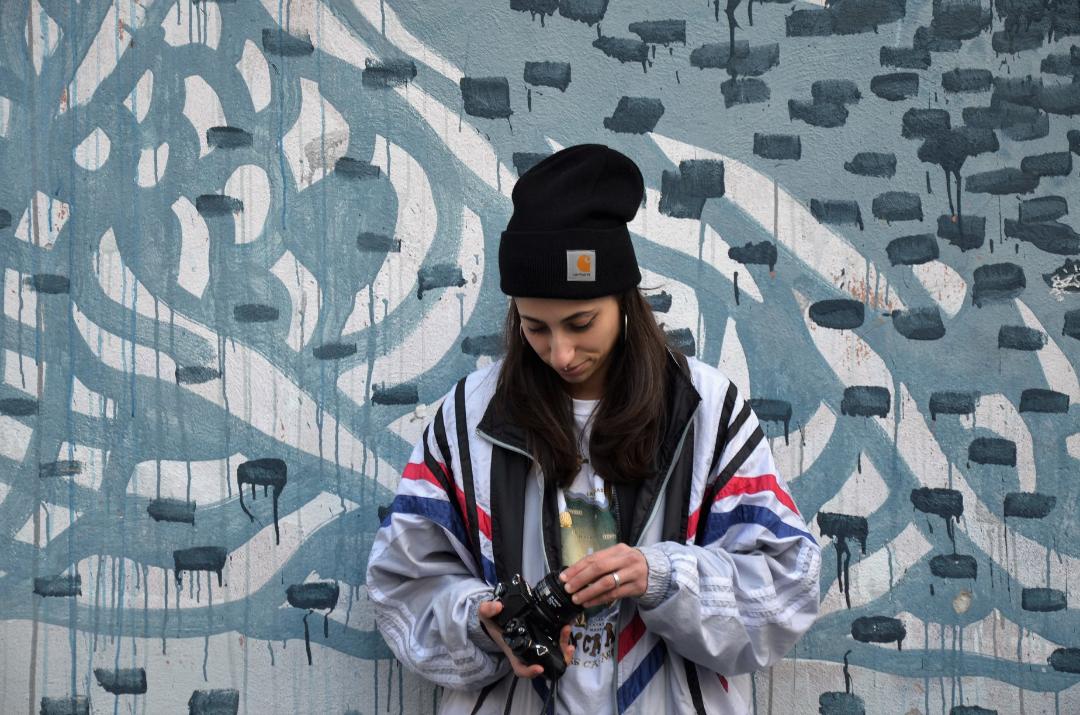Alessia Camoirano Bruges was born in Genoa in 1994. With a Colombian mother and an Italian father, she learned from an early age the thrill of working nomadism, living in many different states of the world: Ecuador, Colmbia, Dubai, Egypt, Tunisia and much more, but “her base”, as she says, has always been Genoa.

Alessia Camoirano Bruges, autoritratto, 2021, courtesy dell’artista
The choice to move to London at eighteen came out of necessity: “I felt suffocated”. So, after an intense year of studies on journalism, the change of direction towards the visual and documentary. “The first years were not easy, I waited a long time before I could work with publications like Vice or channels like Sky, BBC and Chanel 4. I undertook many low-paid internships”. A still vivid past, which has led her, to date, to be nominated for the Emmy Awards. While Alessia carried out her work as a producer and author, at the same time her love for painting grew and became more and more important, becoming a real job, leading her to exhibit in many galleries in London and Europe.

Alessia Camoirano Bruges, Mayfield Falls, 2021, courtesy dell’artista
Her style, initially focused on fluidity and colours, now is focuses on the use of gold leaf, increasingly becoming, over the years, a safe space for the artist to take refuge in. The themes addressed over the years become stronger, moving from melancholy to anguish, finally arriving to the connection with the environment and nature. To date, Alessia is trying to produce without overdoing “otherwise it wouldn’t be art for me, but only art for others”. Many themes and stories emerged with Alessia during our meeting, the details of which we report here.

Alessia Camoirano Bruges, If I can’t have love I want power, exhibition view, 2023, Holy gallery, London, courtesy Holy Gallery
Sara Papini: How did your artistic research begin? What themes have you explored in your artistic journey?
Alessia Camoirano Bruges: My artistic research was born from various needs, in particular that of freeing emotions, exploring the mind, connecting with other people, studying what surrounds me. The need to remain anchored to the present, explore the most difficult moments and try to give a place to melancholy and anguish, a constant study of human interiority, the search for oneself and reflection on the other than oneself, speaking openly about health mental. I explored issues related to anxiety, conflicting and fluctuating emotions. In one of my projects, called Belonging, I wanted to explore my origins. This is because being half Italian and half Colombian I always struggled to understand where I came from or where my home was. In Italy I didn’t know anyone to talk to about these uncertainties and my Colombian side was often ridiculed, while in Colombia I was considered the Italian child. Thanks to art I explored this feeling and discovered that many other people had experienced these feelings of loss. Some works, however, are much more linked to nature, to what surrounds us, to the need to find a moment of beauty and make it fluid: fluidity is the main characteristic of my art.

Painting in studio, Alessia Camoirano Bruges, London, ph: Marina Montalban, courtesy Marina Montalban
Author and producer, but also painter: how do you manage to combine these complex two identities?
I have always felt that both of these two worlds, that of painting and that of cinema, belonged to me deeply. One would not exist without the other. And I can’t give up either of them. Pictorial art is my moment of freedom and release of all the tensions that usually accumulate during the days and, furthermore, it is also and above all a study on mental health. While the part of documentary art and journalism is the part of me that seeks answers, that wants to give voice to others, that wants to tell stories. Certainly, it was not easy to ensure that these two realities could become a job for me and that they could be remunerative enough to support me, especially in a city like London. Art in this capitalist society is often not considered as work. In any case, I never gave up, I am not scared, I will always continue to carry forward all this artistic world of mine that defines me.
Info:
www.alessiacamoiranoart.com
www.theperspectiveproject.co.uk/our-artists

She was born in Genoa but currently lives in Bologna, the city where she graduated from CITEM with a thesis on video art. She works in the world of events in the production sector and is an assistant professor of Visual Studies at UNIBO.






NO COMMENT